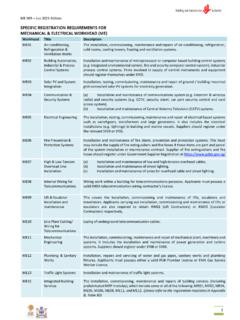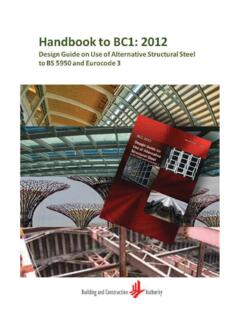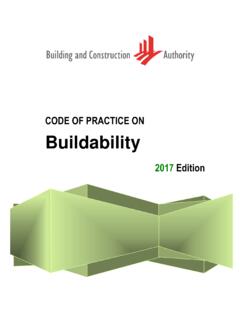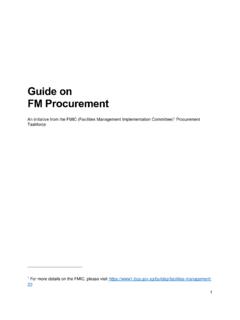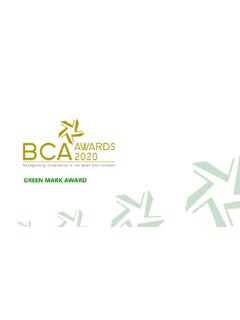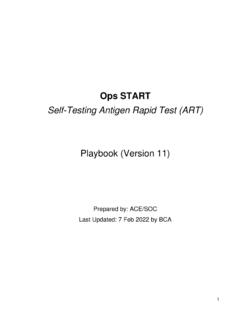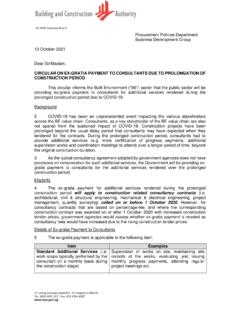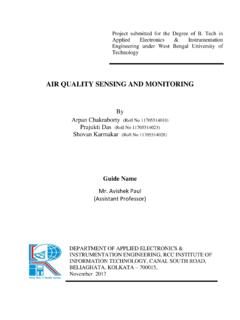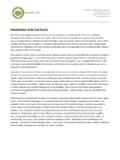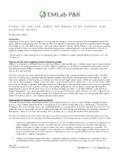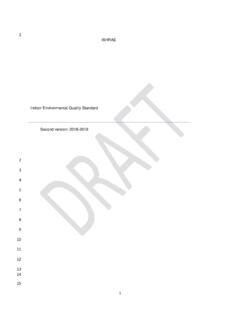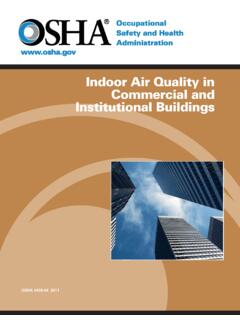Transcription of UPDATED GUIDANCE NOTE ON IMPROVING VENTILATION …
1 Revised on 26 September 2021 UPDATED GUIDANCE NOTE ON IMPROVING VENTILATION AND indoor air quality IN BUILDINGS AMID THE COVID-19 SITUATION 1. Introduction COVID-19 is mainly transmitted by close contact and respiratory droplets which are released when an infected person coughs, sneezes, talks, or sings. It can also be spread through virus aerosols in the air under certain settings, such as enclosed environments which are poorly ventilated. Hence, it is critical to mitigate this risk by IMPROVING VENTILATION and air quality in indoor environments. This GUIDANCE Note provides building owners and facilities managers with UPDATED recommended measures to enhance VENTILATION and air quality in indoor spaces, through the proper operations and maintenance of air-conditioning and mechanical VENTILATION (ACMV)1 systems. It is aimed at reducing disease transmission amid the current COVID-19 situation and resurgence of community cases.
2 Earlier versions of this document were issued on 25 May 2021 and 29 May 2020. This GUIDANCE Note applies to non-residential premises where air-conditioning is used intermittently or continuously, as well as to naturally ventilated premises, with the exception of specialised premises2 such as certain factory production areas, hospitals, polyclinics, and laboratories. Advice from subject matter experts and specialists should be sought for specialised premises. Occupants of residential homes may improve home VENTILATION by opening doors and windows, especially when hosting non-household guests. Fans can be used to promote air circulation when needed. The recommended measures in this GUIDANCE Note should be accompanied by other key measures to reduce disease transmission, such as requiring building occupants to practise safe distancing, wearing masks, and carrying out regular disinfection of high-touch points within the building3. A comprehensive plan should be created for safe management of indoor spaces, including developing communication plans to garner support from occupants, increasing VENTILATION , and ensuring supply of critical items such as filters.
3 Managers should tailor the measures to each space, maximising VENTILATION while taking factors such as the type of VENTILATION system in the indoor space, the area of the indoor space, occupants thermal comfort, and relative humidity into consideration. indoor relative humidity should be closely monitored and maintained according to Singapore Standard SS554:2016 Code of Practice for indoor air quality for Air-Conditioned Buildings. 2. Measures for air-conditioned premises with mechanical VENTILATION provision ( centralised air-conditioning system) Ensure that VENTILATION systems are in good working order: a. Check ACMV systems to ensure adequate VENTILATION in all occupied spaces, based on at least the minimum outdoor air supply rates specified in Singapore Standard SS553:2016 Code of Practice for Air Conditioning and Mechanical VENTILATION in Buildings4. Use of sensors and systems for monitoring outdoor air supply rate should be considered.
4 B. Check AHUs/FCUs/PAUs/FAFs/EAFs5daily to ensure continuous operation, especially in occupied spaces. c. Check all supply air diffusers and exhaust grilles to ensure airflow movement is in the correct direction. d. Maintain ACMV systems regularly. This includes inspecting and cleaning supply fans and exhaust fans to ensure optimal operation, checking air ducts and dampers to ensure no air leakages or blockages, and checking filter seals to avoid air bypass. Recommended maintenance frequencies are specified in SS554:2016 Annex H. Replacement of filters should be done during non-operational periods, with the ACMV system turned off. Used filters should be properly disposed of in sealed bags. Maintenance staff should wear the appropriate PPE, comprising at least N95 masks, eye protection, and gloves, especially when replacing filters. e. Check other systems to ensure there is no undesired air leakage into occupied spaces, including water seals in the sanitary system, cracks in pipes and ducts, and wall gaps.
5 Rectify faults detected. Maximise VENTILATION for indoor air dilution: a. Maximise outdoor air intake and supply by setting AHUs/FCUs/PAUs/FAFs/EAFs to maximum speed and capacity with all air dampers ( volume control dampers) opened fully. Increase outdoor air supply rate to at least 10 L/s/person if the system can accommodate this6. b. Deactivate demand control systems, such as those with CO2 sensors, to avoid automatic reduction of outdoor air supply. c. Open all air dampers and do not block air ducts to ensure optimal provision of outdoor air to all occupied spaces. d. The air distribution system should be balanced to ensure outdoor air provision to all intended spaces. e. Operate exhaust fans ( in toilets, kitchens) at full capacity to expel air from indoor spaces. Keep windows and other openings ( back door) around exhaust fans closed to avoid short-circuiting of air flow. f. Install additional supply and/or exhaust fans if the existing system does not deliver sufficient outdoor air7.
6 G. If the system does not allow for increasing the VENTILATION up to the recommended minimum per person requirement, consider reducing the maximum room occupancy. Purge indoor air before occupancy: a. Perform air purging at least once a day and for at least two hours before each occupancy. Increased purging frequency can be considered for spaces with high disease transmission risk8. b. For buildings without air purging systems, extend operation of ACMV systems with outdoor air intake for two hours before and after each occupancy. Minimise indoor air recirculation; use efficient filters in AHUs to treat recirculated air: a. Set recirculation air dampers to a minimum. b. Use efficient filters (at least MERV14, F8, or ePM1 70-80% is recommended) in AHUs to treat recirculated air. Filters should be properly installed and maintained according to manufacturers recommendation. c. Use of air-cleaning technologies such as ultraviolet germicidal irradiation (UVGI) in AHUs may be considered to augment efficient filters.
7 Efficacy and safety of all air-cleaning devices under the operating conditions must be considered. d. Switch off rotatory heat changers or heat recovery wheels to reduce risk of carry-over leakage from exhaust air. Increase VENTILATION in premises with limited VENTILATION and air filtration provision ( meeting rooms with only FCU): a. Open operable windows and doors as frequently as possible9, unless outdoor/outside air quality is poor. Air-conditioning should be reduced or turned off when doors and/or windows are opened. b. Consider positioning fans to blow air out of windows to increase air exchange. c. Consider adding dedicated outdoor air supply and/or exhaust7. d. Where there is a high risk8 of disease transmission, localised air cleaning may be considered as an interim measure, in line with the recommendation for spaces without mechanical VENTILATION (please see sections and ). 3. Measures for enclosed air-conditioned premises without mechanical VENTILATION provision ( split-unit air-conditioners or FCUs without fresh air supply) Increase VENTILATION and enhance air exchange: a.
8 Open operable windows and doors as frequently as possible9, unless outdoor air quality is poor. Air-conditioning should be reduced or turned off when doors and/or windows are opened. b. Consider adding dedicated outdoor air supply and/or exhaust7. c. Operate exhaust fans ( in toilets, kitchens) at full capacity to expel air from indoor spaces. Keep windows or other openings ( back door) around exhaust fans closed to avoid short-circuiting of air flow. Consider installing window-mounted exhaust fans to enhance VENTILATION : a. The fan systems should at least provide the minimum air changes specified in SS553:2016. b. Air supply and exhaust system can be aligned to provide uni-directional airflow in a poorly ventilated space. c. To cater for occasions of poor outdoor air quality ( haze), consider getting fans with coverings that can cover up the fans when needed. As a longer-term solution, supply air fans fitted with efficient filters (at least MERV14, F8, or ePM1 70-80% is recommended) can also be considered to maintain good VENTILATION during haze episodes.
9 Such systems should be installed by professionals to ensure good filtration and supply air distribution. In enclosed spaces with high risk8 of disease transmission, portable air cleaners for localised air cleaning may be considered as an interim measure: a. Portable air cleaners should be equipped with high-efficiency air filters such as HEPA filters, which are effective at removing virus aerosols. b. The clean air delivery rate (CADR) or equivalent of a portable air purifier should be used to determine the size and number of portable air cleaner devices needed in a space10. c. If present, the portable air cleaner s ozone generation function should be turned off to avoid potential exposure to excessive levels of ozone and undesirable by-products, which may be hazardous to health. d. The use of portable air cleaners should be considered an interim measure. Air cleaning does not replace the need for adequate VENTILATION . Regular surface cleaning and disinfection3 should also continue, as portable air cleaners do not remove surface contamination.
10 E. Please refer to NEA s Technical Advisory on Use of Air-Cleaning Technologies to Mitigate COVID-19 Aerosol Transmission Risk for more information on the use of portable air cleaners. Where ceiling height allows, upper-room UVGI may be considered for air cleaning. As viral disinfection efficacy and safety (UV-C radiation can cause injury to the eyes and skin) are greatly dependent on the system and how it is installed and maintained, professional services must be used. Please refer to NEA s Technical Advisory on Use of Air-Cleaning Technologies to Mitigate COVID-19 Aerosol Transmission Risk for more information. Check other systems to ensure there is no undesired air leakage into occupied spaces, including water seals in the sanitary system, cracks in pipes and ducts, and wall gaps. Rectify faults detected. 4. Measures for naturally ventilated premises Natural VENTILATION is weather dependent. It could be limited to the areas around windows and doors (perimeter zones), with little air exchange in the inner portion of the space (internal zones).

